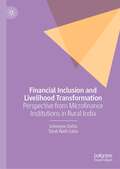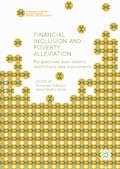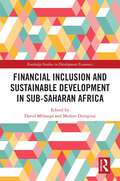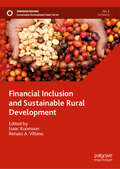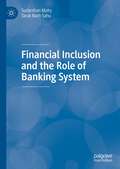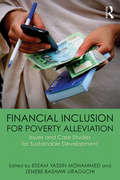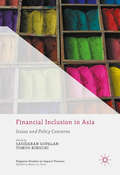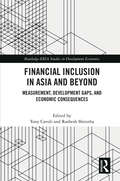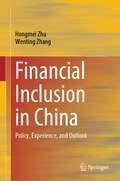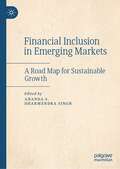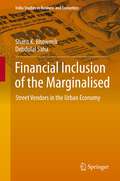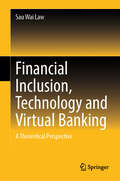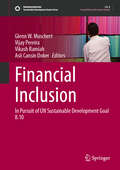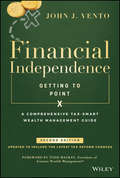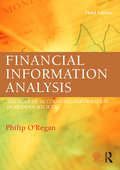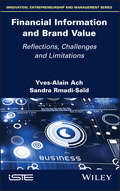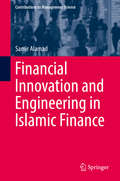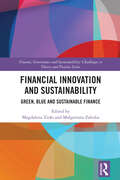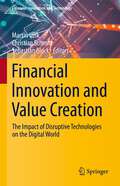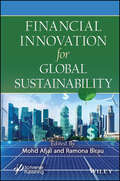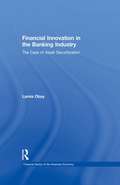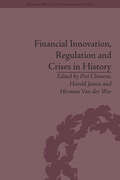- Table View
- List View
Financial Inclusion and Livelihood Transformation: Perspective from Microfinance Institutions in Rural India
by Tarak Nath Sahu Srimoyee DattaThis book explores the role and effect of Microfinance Institutions (MFIs) with different dimensions. It is being supported with strong empirical evidence into various parameters of MFIs directed towards inclusive finance and the transformation journey of livelihoods of its beneficiaries.It also incorporates empirical evidence with the perception of both beneficiaries and non-beneficiaries. Starting its journey toward the path of comprehending how MFIs make their footprint among the excluded population in the selected areas, it incorporates the different outcomes of MFI lending like credit utilisation patterns, income generation, and employability. As financial stability helps to break out the vicious cycle of poverty, this book emphasises the self-dependent element for the beneficiaries and their households. It addresses the important issue of the female counterparts in society. It shows how the MFIs work actively to generate female empowerment from multiple dimensions among the selected communities. It addresses key issues to consider for inclusive policy formulation, especially for backward communities in the backward areas and gives a realistic scenario of the MFI activities, their interactions with the respondents, the various outcomes, and areas for further developments, etc. This book is beneficial for academicians, researchers, and policymakers.
Financial Inclusion and Poverty Alleviation: Perspectives from Islamic Institutions and Instruments (Palgrave Studies in Islamic Banking, Finance, and Economics)
by Muhamed Zulkhibri Abdul Ghafar IsmailThis book explores the relationships between financial inclusion, poverty and inclusive development from Islamic perspectives. Financial inclusion has become an important global agenda and priority for policymakers and regulators in many Muslim countries for sustainable long-term economic growth. It has also become an integral part of many development institutions and multilateral development banks in efforts to promote inclusive growth. Many studies in economic development and poverty reduction suggest that financial inclusion matters. Financial inclusion, within the broader context of inclusive development, is viewed as an important means to tackle poverty and inequality and to address the sustainable development goals (SDGs). This book contributes to the literature on these topics and will be of interest to researchers and academics interested in Islamic finance and financial inclusion.
Financial Inclusion and Sustainable Development in Sub-Saharan Africa (Routledge Studies in Development Economics)
by David Mhlanga Mufaro DzingiraiThis book delves into the transformative power of the Fourth Industrial Revolution (4IR) in reshaping the landscape of sustainable development in one of the world's most vibrant regions. This edited volume explores the synergy between cutting-edge digital technologies and innovative financial strategies to drive responsible business practices that align with the Sustainable Development Goals (SDGs).This book navigates the complex interplay between technological advancements, financial inclusion, corporate social responsibility, environmental stewardship, and ethical governance. It critically assesses how digital innovations—ranging from artificial intelligence, blockchain, and the Internet of Things (IoT) to green technologies and fintech—alongside novel financial instruments such as green bonds and impact investing, can address key concerns such as poverty alleviation, gender parity, and environmental sustainability. With a wide range of expert contributions, this volume offers useful insights and practical solutions to promote financial inclusion and encourage sustainable growth in Sub-Saharan Africa. It achieves this through a combination of empirical research, case studies, and policy analysis.This resource is crucial for policymakers, scholars, and development practitioners who are dedicated to advancing inclusive and sustainable development.
Financial Inclusion and Sustainable Rural Development (Sustainable Development Goals Series)
by Isaac Koomson Renato A. VillanoThis book compiles topics on how financial inclusion, from either unidimensional or multidimensional perspectives, can be used as a viable policy tool to achieve sustainable development goals (SDGs) in rural/regional areas. Part I of the book sets the scene by providing a thematic overview of the SDGs and the theoretical link between financial inclusion and SDGs from the rural perspective. Parts II to VI present several empirical studies/chapters that explore the impact of financial inclusion on specific goals and targets of the SDGs in rural areas across various regions/continents. Part VII draws on the findings from Parts I and VI to provide a discourse on the viability of financial inclusion as an effective policy for achieving the SDGs in rural areas across the globe.
Financial Inclusion and the Role of Banking System
by Tarak Nath Sahu Sudarshan MaityThe book portrays the scope and dimension of different financial inclusion strategies. It looks at the role and potential of banks involved in financial inclusion. This book focuses on the importance of financial inclusion and in measuring its important determinants. It provides an empirical insight into how the different factors influence financial inclusion of a nation, providing a guideline to the banks and the regulators to select an effective structure of bank branch and efficient composition, to ensure best utilization of their devoted resources in the context of a developing economy.
Financial Inclusion at Omidyar Network
by Vikram Gandhi James Barnett Caitlin Lindsay Reimers BrummeA team of investors at Omidyar Network explore two different investment possibilities in the budding financial inclusion space, using their investment framework to consider capital alternatives available for both investments, each of which carries highly divergent financial and impact potential.
Financial Inclusion for Poverty Alleviation: Issues and Case Studies for Sustainable Development
by Essam Mohammed Zenebe UraguchiMore than one billion people still live below the poverty line – most of them in South Asia and Sub-Saharan Africa. Financial inclusion is a major issue, as more than three-quarters of the numbers of poor and disadvantaged women and men do not have access to financial products and services, such as bank accounts, affordable and suitable loans, and insurance. The key objective of this book is to provide practical case studies of financial inclusion, rather than focus on academic debates such as the ideological basis of promoting microfinance. Using the recently adopted Sustainable Development Goals as an overall framing of the issues, it shows how poor and disadvantaged women and men can be bankable if the right facilitation for maximizing opportunities and addressing constraints are in place. Case studies confirm that achieving inclusive and sustainable access to financial products and services goes beyond simply enabling poor and disadvantaged women and men to have access to credit, or the ability to open a bank account. Examples from Africa, Asia and Latin America demonstrate encouraging progress in making microcredit accessible to millions of poor people. The foremost challenge, however, has been to ensure that they have access to, and usage intensity of, suitable and affordable financial products and services that meet the needs of their livelihoods as well as risks and mitigation strategies. This requires understanding that poor and disadvantaged women and men do not exist in isolation from complex and interdependent functions in the financial system, which includes a number of actors, diversified services, constraints (not just symptoms) and capacities and incentives. Overall, the book provides a rich source of examples of how building inclusive financial systems can empower the world's poor – by increasing income and employment opportunities, securing livelihoods and reducing poverty.
Financial Inclusion in Asia
by Sasidaran Gopalan Tomoo KikuchiThis book brings together a set of analytical and empirical essays aimedat understanding inclusive finance in emerging markets focusing on Asia. Despite the significant policy interest in the issue of financial inclusion inthe Asian market, there is a dearth of academic literature on the topic. Thisbook fills this gap by being the first of its kind to address the relevantissues and policy concerns relating to the availability and affordability offinancial services in this rapidly emerging geopolitical area. The bookfeatures a mixture of empirical and case study oriented essays, informed bydata, literature and policy analysis that will be useful for both the academicsand the policy makers in the region interested in the subject. Countrieshighlighted in the essays assessing financial inclusivity include Indonesia,Sri Lanka and India.
Financial Inclusion in Asia and Beyond: Measurement, Development Gaps, and Economic Consequences (Routledge-ERIA Studies in Development Economics)
by Tony CavoliThe World Bank considers financial inclusion to be an enabler for at least 7 of the 17 United Nation’s sustainable development goals (SDGs). Financial inclusion, with its associated policy implications, is an important issue for ASEAN. This book examines the economic effects of financial inclusion. It explores issues surrounding measurement and impact of financial inclusion. The book looks at various, salient topics including measurement of financial inclusion, the impact of (various indicators of) financial inclusion on development outcomes and macroeconomic volatility using aggregate data, as well as the effects of financial inclusion on poverty and development outcomes using micro data.
Financial Inclusion in China: Policy, Experience, and Outlook
by Hongmei Zhu Wenting ZhangThis book aims to provide first-hand information for readers who are concerned about inclusive finance and sustainable development by summarizing China’s policy measures and practical innovations in the development of inclusive finance and expects to provide China’s experience for the development of inclusive finance in more regions. From a worldwide perspective, a large number of people had been excluded from formal financial services for a long time due to various factors. Even in developed economies with sound financial systems, relatively disadvantaged groups are often denied access to effective financial services. In 2005, the United Nations proposed the concept of Inclusive Finance, emphasizing the extension of financial services to less developed regions and low-income groups in society at an affordable cost by improving financial infrastructure and providing them with reasonably priced and convenient financial services. In 2015, the United Nations adopted the 2030 Agenda for Sustainable Development, making inclusive finance an important focus for achieving sustainable development. It has become a global consensus to vigorously develop inclusive finance. China has attached importance to improving financial services for disadvantaged groups such as rural residents, micro-, small and medium enterprises (MSMEs) and others. In 2013, Developing “Inclusive Finance” became China’s national strategy. In 2015, China formulated the Plan for Promoting the Development of Inclusive Finance (2016-2020). In 2016, during its presidency of the Global Partnership for Financial Inclusion (GPFI), China proposed the issue of "Digital Financial Inclusion" and issued the G20 High-level Principles for Digital Financial Inclusion at the G20 Hangzhou Summit in the same year. Through policy guidance and active practice by the financial sector, China has gradually formed a unique development model of inclusive finance and achieved remarkable successes. Physical outlets, service machines and online service channels have been improved, and basic financial services have generally covered both urban and rural areas. The financial services for rural households and MSMEs have improved significantly. The efficiency and convenience of financial services have been significantly improved, and the satisfaction of financial services has significantly increased. China's experience in inclusive finance has been recognized by the international community. In 2017, five cases from China were selected in the G20 report on Digital Financial Inclusion: Emerging Policy Approaches.
Financial Inclusion in Emerging Markets: A Road Map for Sustainable Growth
by Ananda S. Dharmendra SinghThis book discusses ideas for stakeholders to develop strategies to access and use financial products and services such as deposits, loans, and fund transfer mechanism, insurance, payment services, and intermediaries, distribution channels at economical prices in order to cater to the needs of the poor and underprivileged people. Financial inclusion ensures ease of access, availability, and usage of the financial products and services to all the sections of the society. The book will help in recognizing the role of financial inclusion as one of the main drivers in reducing income inequality and thus supporting sustainable economic growth of the countries, especially of an emerging economy. The book provides conceptual and practical ideas from the practitioners, best practices from the experts, and empirical views from the researchers on the best practices and how to mitigate the challenges and issues plaguing the development of the financial inclusion.
Financial Inclusion of the Marginalised: Street Vendors in the Urban Economy
by Debdulal Saha Sharit K. BhowmikThis book is the product of a study conducted by the Tata Institute of Social Sciences (TISS) in collaboration with the United Nations Development Programme (UNDP) and Ministry of Urban Housing and Poverty Alleviation (MoHUPA). Its objective is to highlight some of the problems faced by street vendors in conducting their daily business and to examine how financial institutions, especially those in the banking sector, can include street vendors in their credit policies. Data was collected from 15 cities across the country. Not surprisingly, while issues such as public space utilisation have been deliberated upon at length, those concerning the nature of credit transactions and concurrently the financial inclusion of street vendors have scarcely received focussed attention. In the absence of formal credit, street vendors largely depend on loan sharks, who charge high interest rates ranging from 350% to 800% per annum. The problem of formal credit aside, another equally important factor is the inflexible attitude of the civic authorities towards street vending. Given their informal status, this is particularly apparent because they are forced to conduct business in the absence of legal protection, making them vulnerable to rent seeking by the authorities. The acceptance of the National Policy for Urban Street Vendors by a few states and the subsequent bill to protect the livelihood of street vendors should help them gain legitimacy and subsequently credit to run their businesses at proper rates. The book examines and analyses these issues.
Financial Inclusion, Technology and Virtual Banking: A Theoretical Perspective
by Sau Wai LawThis book challenges the notion that technology promotes financial inclusion. Drawing insights from the retail banking industry in Hong Kong, it explores the potential drawbacks of technology adoption. The book combines existing articles, regulatory case studies, and interviews with customers and practitioners to propose four factors that measure digital financial inclusion, defined as the impact of technology on financial inclusion, from the customer's viewpoint. It offers practical guidance by identifying business incentives for banks and providing law and policy recommendations for regulators. This book serves as a valuable resource for scholars, regulators, and practitioners in law and social sciences, shedding light on the complex relationship between technology and financial inclusion while bridging the gap between supply-driven approaches and customer demands.
Financial Inclusion: In Pursuit of UN Sustainable Development Goal 8.10 (Sustainable Development Goals Series)
by Vijay Pereira Vikash Ramiah Glenn W. Muschert Asli Cansin DokerThis volume presents an academic discussion of SDG sub-goal 8.10, which involves increasing financial inclusion via enhancing access to banking, insurance, and other financial services. It examines the challenges that prevent many from accessing financial services and analyses strategies governments, financial institutions, and NGOs can use to promote broader financial inclusion. It also explores economic, sociological, financial, and other social sciences/business perspectives on SDG 8.10 and its key indicators. Featuring global and regional topics and country studies, this volume provides an interdisciplinary approach to financial inclusion that informs, inspires, and catalyzes action for a more inclusive and sustainable global economy.
Financial Independence (Getting to Point X): A Comprehensive Tax-Smart Wealth Management Guide
by John J. VentoDiscover how the Tax Cuts and Jobs Act of 2017 will change your journey to financial independence and what you need to do now to take advantage of the new law Financial Independence (Getting to Point X) offers practical, time-tested advice for reaching your financial goals—whatever they may be. Whether you’re recovering from debt, putting kids through college, planning for retirement, starting your own business, or just seeking a healthier financial outlook, this book shows you how to get it done. No platitudes or empty advice here—just a clear roadmap to your goals, based on the effective management of the 10 Key Wealth Management Issues that threaten to derail us all. This new second edition has been updated to reflect President Trump’s massive income tax changes. These historic changes will reduce the tax obligation of most Americans, but not all. This is the most significant tax reform in over 30 years, rendering old advice obsolete while opening new opportunities. This edition also includes a new chapter on becoming financially independent by starting your own business. Author John Vento knows exactly what these new laws entail, and this book puts his wisdom of experience to work for you to help you get on track to financial freedom. Saving, budgeting, managing debt, minimizing taxes, and living within your means—all classic financial advice, but easier said than done, right? In this book, you’ll find real, practical advice for actually doing it—to the extent that makes sense for you. Understand the enormous changes taking place in the federal income tax code Learn which financial strategies have become obsolete, and what new opportunities you should take advantage of Negotiate your way through the 10 Key Wealth Management Issues with expert advice Find out if you have what it takes to reach financial independence by starting your own business Follow a clear roadmap to financial independence, no matter how you define it The goal is not perfection on all fronts, it’s simply tailoring your journey to suit your destination. No unnecessary deprivation, no obsessive adjusting—simply paying attention to key issues may be enough, depending on your goal. Regulatory changes close some doors but open others, and opportunities still exist if you know where to look. Financial Independence (Getting to Point X) provides you with a roadmap to financial freedom, so that you can achieve your life goals and dreams.
Financial Independence for Women: Take Control of Your Money and Live a Balanced Life
by Vered NetaFinancial Independence for Women is about waking up, taking action, and moving forward. In Financial Independence for Women, leading success trainer Vered Neta presents a step-by-step guide to taking control of your money in just six weeks. By discovering the obstacles that keep us from financial success and how to break through them, we can reach financial independence and become role models for ourselves, our daughters, and our world.
Financial Infidelity
by Bonnie Eaker WeilFinancial Infidelity is the #1 problem in relationships - it's a deception so subtle you wouldn't even realize you're cheating. Whether it's a secret credit card, hidden shopping bags, revenge spending, a gambling problem, or more overt financial manipulations and powerplays, the infidelities associated with money can be just as damaging to a relationship as a physical affair. Dr. Bonnie, one of the nation's leading couples therapists, is the first to offer cutting-edge solutions to this pervasive relationship threat, enabling you to:* Identify the risk of Financial Infidelity in your relationship* Understand how buying, rewarding, or controlling behavior with money can open the door to lies, betrayals, and affairs* Understand how childhood relationships to money and love can create damaging emotional links* Separate the value of your relationship from the value of your bank account* Disconnect from harmful emotional and financial behaviors in order to reconnect with your partner and regain trust, intimacy, and romantic sizzleFinancial Infidelity addresses the recent shift in power and money between men and women, and exposes the money, sex, and love triangle, helping you to uncover the hidden financial problems in refinancing your relationship and to heal the inevitable emotional fallout. Dr. Bonnie has a 98 percent rate of success in counseling her patients - this book is an invaluable tool and the next best thing to a session with the doctor herself!
Financial Information Analysis: The role of accounting information in modern society
by Philip O'ReganThe accounting landscape shifted following the era of global financial crisis and accounting information continues to play a vital role. Philip O’Regan’s authoritative textbook provides readers with the tools and techniques to fruitfully analyse accounting and financial data. Updated to reflect changes in corporate governance, regulatory frameworks and new forms of IFRS, the text continues to shed light on the growing emphasis placed on the role of accounting information in formulating financial strategy. Features which add value to this third edition of Financial Information Analysis include case studies in every chapter with numerous supporting articles from the major financial presses, questions for review, and a comprehensive companion website. This essential textbook is core reading for advanced undergraduate and postgraduate students of finance and accounting.
Financial Information and Brand Value: Reflections, Challenges and Limitations
by Yves-Alain Ach Sandra Rmadi-SaïdThe brand is the company's most important asset. In their financial statements, companies are faced with a lack of accounting recognition for the brands they have created, and value recognition for the brands they have acquired. This book studies the nature, characteristics and determinants of brand information published in companies' annual and financial reports. It presents case studies on the methods of evaluating and developing brands, and analyzes annual reports published by listed companies, whose brands appear in international rankings. It reflects on the inadequacy of information and disclosed data to demonstrate the value of brands and the need to ensure that more reliable and relevant financial information is available to investors. Financial Information and Brand Value goes beyond the simple application of conceptual frameworks in order for the reader to master the practices related to brand valuation.
Financial Innovation and Engineering in Islamic Finance
by Samir AlamadThis book provides two important contributions to existing theories in the financial innovation literature. First, it extends the existing literature of innovation orientation to a completely new field and construct that is based on a religious imperative as a framework within which financial innovation is constrained. It explains how an innovation orientation in IFIs can be directed within religious rules, which indicates that innovation orientation in IFIs is a learning philosophy. Second, the book introduces and examines the plasticity of Shariah as a shared boundary object and its dynamic role in managing tension and conflicting values in the financial innovation process. Furthermore, building on the empirical results, the study illustrates the insights that each theoretical lens affords into practices of collaboration and develops a novel analytical framework for understanding religious orientation towards financial innovation. This practical contribution, of the developed framework, could form the basis for a standardised framework for the Islamic finance industry. The book concludes by noting the policy and managerial implications of its findings and provides directions for further research.
Financial Innovation and Sustainability: Green, Blue and Sustainable Finance (Finance, Governance and Sustainability)
by Magdalena Zioło Małgorzata ZaleskaIn recent years, factors such as sustainability, digitalization, climate change, energy transformation, social inclusion, gender parity, and Environmental, Social and Governance (ESG) risk have been playing an increasingly important role in the process of financial transformation. The effect of the impact is increased regulation and guidance for financial markets, in relation to adapting current activities to meet the new challenges, for example: The process of greening finance and spreading the blue wave in finance Building sustainable value in the business models of financial institutions Creating an offer of sustainable financial products Ensuring parity between women and men in the decision-making bodies of financial institutions Sustainable ratings Climate stress tests This book focuses on the intersection between nature and finance and offers a comprehensive overview of the trends, transformations and challenges in finance and the financial markets related to the effects of sustainability concepts or ESG factors. The book has been designed to show these trends, through the evolving subdisciplines of finance, such as green and blue finance. It presents critical recommendations for the ecosystem and network of finance in the era of ESG and sustainability and paints a comprehensive picture of contemporary finance, identifying the factors determining its sustainable transformation.This is one of the first books to present the issues of sustainability and ESG risk in finance through the prism of individual types of finance. Not only will the book appeal to scholars and researchers in the field of banking, economics, finance and accounting, but it will also find an audience among policymakers and practitioners involved in the finance and sustainability discourse.
Financial Innovation and Value Creation: The Impact of Disruptive Technologies on the Digital World (Financial Innovation and Technology)
by Christian Schmitz Martin Užík Sebastian BlockThis contributed volume provides academic insights into the digital financial world. It illustrates the state-of-the-art research on financial technology and innovation with special focus on the impact in society. Technologies are not only door openers for the digital world, but they are also key drivers of change. These key drivers of digitalization, accelerating the pace, are literally forcing individuals to adapt. The authors discuss these dynamics and reflect on society’s adaptability. The first part of the book focuses on cryptocurrencies as disruptive technology. It discusses the status quo, future trends and legal frameworks for virtual money. The second part of the book sheds light on value creation in a digitalized world. The authors discuss digital platforms and economic networks and the impact of digital dominance.
Financial Innovation for Global Sustainability
by Mohd Afjal Ramona BirauFinancial Innovation for Global Sustainability provides essential insight and practical strategies for navigating the evolving landscape of sustainable finance to demonstrate how FinTech can drive environmental sustainability and promote inclusive economic growth. Financial Innovation for Global Sustainability centers on the integration of financial technology (FinTech) with sustainable development and inclusive economic growth. This volume delves into how FinTech can be leveraged to promote environmental sustainability, enhance financial inclusion, and support equitable economic development. The content will explore various aspects of sustainable finance, including green finance, digital financial services, and the role of innovation in driving sustainability within the financial sector. A multi-disciplinary approach draws insights from finance, economics, technology, and environmental studies and features empirical research, case studies, theoretical analyses, and policy discussions. This book will not only discuss current trends and innovations in sustainable FinTech but critically analyze challenges, regulatory hurdles, and ethical considerations. In essence, the book will serve as a comprehensive resource on sustainable financial innovation, offering insights into how FinTech can be a catalyst for positive change in the global financial landscape. Sustainable FinTech sits at the intersection of financial innovation, environmental sustainability, and social equity, reflecting a broader shift in how industries and disciplines are evolving to address the complex challenges of the 21st century. Financial Innovation for Global Sustainability situates itself within this critical discourse, offering a comprehensive exploration of how FinTech can be harnessed to lead the charge towards a sustainable and inclusive future.
Financial Innovation in the Banking Industry: The Case of Asset Securitization (Financial Sector of the American Economy)
by Lamia ObayThis book investigates the motivations behind the adoption of the technique of asset securitization by US commercial banks and its effects on the financial performances.
Financial Innovation, Regulation and Crises in History (Banking, Money and International Finance #2)
by Harold JamesWith contributions from world-renowned figures such as Niall Ferguson and Adair Turner, this volume investigates how financial institutions and markets have undergone or reacted to past pressures, and the regulatory responses that emerged as a result.
